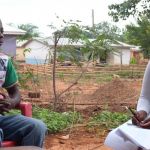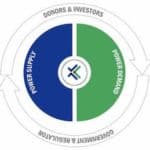Bringing Digital Financial Inclusion to Women: The Impact of an Integrated Ecosystem Approach
Despite global initiatives aimed at catalyzing formal banking and increasing the usage of digital channels, almost 1 billion women still remain excluded from the global financial economy.
Close to 14% of total establishments in India are managed by women, and these businesses provide employment to roughly 13.5 million people. But while the Indian economy has grown at an accelerated pace in the past decade, the workforce participation of women has seen a decline from 35% in 2005 to 26% in 2018. This clearly indicates that either the growth in the economic empowerment of women has not been in sync with the economic growth of the country, or women are not included in the formal economy, despite performing many economic activities. The global statistics reveal a similar issue, with 56% of the unbanked being women and just 41% of women being part of the work force.
In recent years, there have been a slew of global initiatives introduced to integrate women into the formal economy, but the comprehensive financial inclusion of women is still a distant dream. Further complicating this challenge is the fact that just having a bank account is not sufficient to consider women financially included. In India, almost half of all accounts are dormant and don’t provide the real benefits that digital financial services (DFS) can bring, such as access to credit, reductions in cash risk due to the use of mobile money transfers and savings, increases in disposable income, and better personal financial management.
It’s clear that financial inclusion for women cannot be attained by simply opening them an account, or giving them access to a phone and internet. It will entail a cultural shift that will involve the men in the house, the local community and catalytic partnerships.
The Barriers to Women’s Financial Inclusion
Traditionally, women in rural communities are highly reliant on men to make financial decisions for the household. In most cases, the men are the owners of a family’s mobile phones – and even when women have bank accounts, the men generally manage these accounts. Since women often do not have visibility of the family’s income and expenses, they are unable to contribute to the financial management of the household.
Women’s transition into financial inclusion is held back by the psychological barriers they face while accessing DFS. These barriers include reluctance to own a mobile phone, self-doubt while using a smartphone, hesitation in attending training events due to the unequal gender ratio at the training centers, and a broader fear of technology. These obstacles are amplified by the absence of a local support system, in the form of female change agents or women support groups led by more progressive members of the community.
This exclusion means that where women are working in rural geographies, their incomes are rarely credited in their bank accounts. Even if these incomes get credited, it can be intimidating for people in rural communities – especially women – to visit the bank, stand in queues and complete long application forms. The foundation for financial inclusion stands on three pillars – access, trust and comfort. But this foundation cannot be built through a single government policy or a development agency in isolation. Instead, it will entail a range of partnerships across technology, banking, the rural-focused private sector and government departments.
Rural Value Chains Can Create an Integrated Digital Financial Ecosystem for Women
Unless women reliably find value in using their bank accounts, no initiative can spur their financial inclusion. The active usage of accounts through credit-debit transactions is a critical success factor for catalyzing financial inclusion, and also the necessary first step for women to adopt digital mediums for conducting financial transactions. A large number of women’s accounts remain dormant due to negligible credit and debit activity. By identifying the prevalent income-generating activities or value chains among women customers and connecting these income streams to their accounts, greater account usage can be activated. This will also form the first link of a sustainable digital financial transaction chain.
However, in order to alleviate women’s fear of losing their digital money, a cash deposit and withdrawal facility will need to be created within their reach. This can be facilitated through last-mile banking agents. Moreover, if these banking agents belong to the local community, the pace of adoption can be accelerated. When there is trust among women that they can access cash at their convenience, they will withdraw only the requisite amount and start saving, establishing the second link of the digital financial transaction chain.
But while income and savings can kickstart the usage of digital mediums, the chain will remain unsustainable without a conduit for spending, using the same account. Here, the merchants in the women’s vicinity will need to be on-boarded to accept digital payments.
To complete the integrated digital financial transaction ecosystem, data generated from digital incomes, savings and spending can be utilized to build digital financial profiles of the women, which can then enable improved financial access for them.
A Model for Digitizing Financial Access for Women
Intellecap has digitized over 800 women across 30 villages in India by building an integrated digital financial ecosystem for them, following the approach outlined above.
We did this by implementing integrated rural digital financial ecosystem pilots for women-dominant agriculture value chains, including dairy, poultry and food processing, across selected geographies in India. The pilots have demonstrated success on several primary metrics such as income, savings and productive time for smallholder women farmers. As secondary gains, these women have built higher awareness of digital channels of transactions, and gained more financial independence through better control over their income and expenses.
In our dairy value chain digitization pilot, 36% of financially excluded women in the pilot villages were included in the formal economy, and 80% of the participating women dairy farmers also reported an increase in savings. Through the pilot for the food and beverages value chain, 75% of self-help groups for women entrepreneurs improved sales in their businesses through market linkages using digital platforms.
The unique value propositions of the pilot partners – which ranged from rural value chain aggregators to payment/commercial banks and lending fintechs – have ensured that these pilots continue to scale. The integrated ecosystem model endeavors to first establish the roots of digital financial services deployments, and then branch out in phases. It therefore presents the most sustainable way to replicate digitization across varied value chains, both formal and informal, enabling comprehensive inclusion for women across geographies.
Ankur Seth is Engagement Manager and Neha Kumar is Senior Associate at Intellecap.
Photo courtesy of Ashutosh Negi.
- Categories
- Finance



